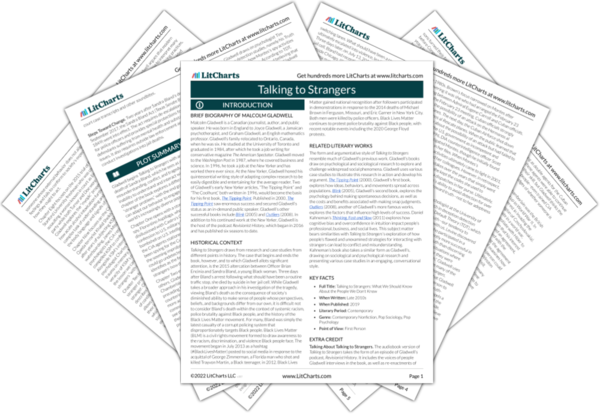Brian Encinia Quotes in Talking to Strangers
When we don’t know someone, or can’t communicate with them, or don’t have the time to understand them properly, we believe we can make sense of them through their behavior and demeanor.

Unlock explanations and citation info for this and every other Talking to Strangers quote.
Plus so much more...
Get LitCharts A+Like suicide, crime is tied to very specific places and contexts. Weisburd’s experiences in the 72nd Precinct and in Minneapolis are not idiosyncratic. They capture something close to a fundamental truth about human behavior. And that means that when you confront the stranger, you have to ask yourself where and when you’re confronting the stranger—because those two things powerfully influence your interpretation of who the stranger is.
There is something about the idea of coupling—of the notion that a stranger’s behavior is tightly connected to place and context—that eludes us. It leads us to misunderstand some of our greatest poets, to be indifferent to the suicidal, and to send police officers on senseless errands. So what happens when a police officer carries that fundamental misconception—and then you add to that the problems of default to truth and transparency? You get Sandra Bland.
To Encinia’s mind, Bland’s demeanor fits the profile of a potentially dangerous criminal. She’s agitated, jumpy, irritable, confrontational, volatile. He thinks she’s hiding something. This is dangerously flawed thinking at the best of times. Human beings are not transparent. But when is this kind of thinking most dangerous? When the people we observe are mismatched: when they do not behave the way we expect them to behave.
Brian Encinia’s goal was to go beyond the ticket. He had highly tuned curiosity ticklers. He knew all about the visual pat-down and the concealed interrogation. And when the situation looked as if it might slip out of his control, he stepped in, firmly. If something went awry that day on the street with Sandra Bland, it wasn’t because Brian Encinia didn’t do what he was trained to do. It was the opposite. It was because he did exactly what he was trained to do.

Brian Encinia Quotes in Talking to Strangers
When we don’t know someone, or can’t communicate with them, or don’t have the time to understand them properly, we believe we can make sense of them through their behavior and demeanor.

Unlock explanations and citation info for this and every other Talking to Strangers quote.
Plus so much more...
Get LitCharts A+Like suicide, crime is tied to very specific places and contexts. Weisburd’s experiences in the 72nd Precinct and in Minneapolis are not idiosyncratic. They capture something close to a fundamental truth about human behavior. And that means that when you confront the stranger, you have to ask yourself where and when you’re confronting the stranger—because those two things powerfully influence your interpretation of who the stranger is.
There is something about the idea of coupling—of the notion that a stranger’s behavior is tightly connected to place and context—that eludes us. It leads us to misunderstand some of our greatest poets, to be indifferent to the suicidal, and to send police officers on senseless errands. So what happens when a police officer carries that fundamental misconception—and then you add to that the problems of default to truth and transparency? You get Sandra Bland.
To Encinia’s mind, Bland’s demeanor fits the profile of a potentially dangerous criminal. She’s agitated, jumpy, irritable, confrontational, volatile. He thinks she’s hiding something. This is dangerously flawed thinking at the best of times. Human beings are not transparent. But when is this kind of thinking most dangerous? When the people we observe are mismatched: when they do not behave the way we expect them to behave.
Brian Encinia’s goal was to go beyond the ticket. He had highly tuned curiosity ticklers. He knew all about the visual pat-down and the concealed interrogation. And when the situation looked as if it might slip out of his control, he stepped in, firmly. If something went awry that day on the street with Sandra Bland, it wasn’t because Brian Encinia didn’t do what he was trained to do. It was the opposite. It was because he did exactly what he was trained to do.











